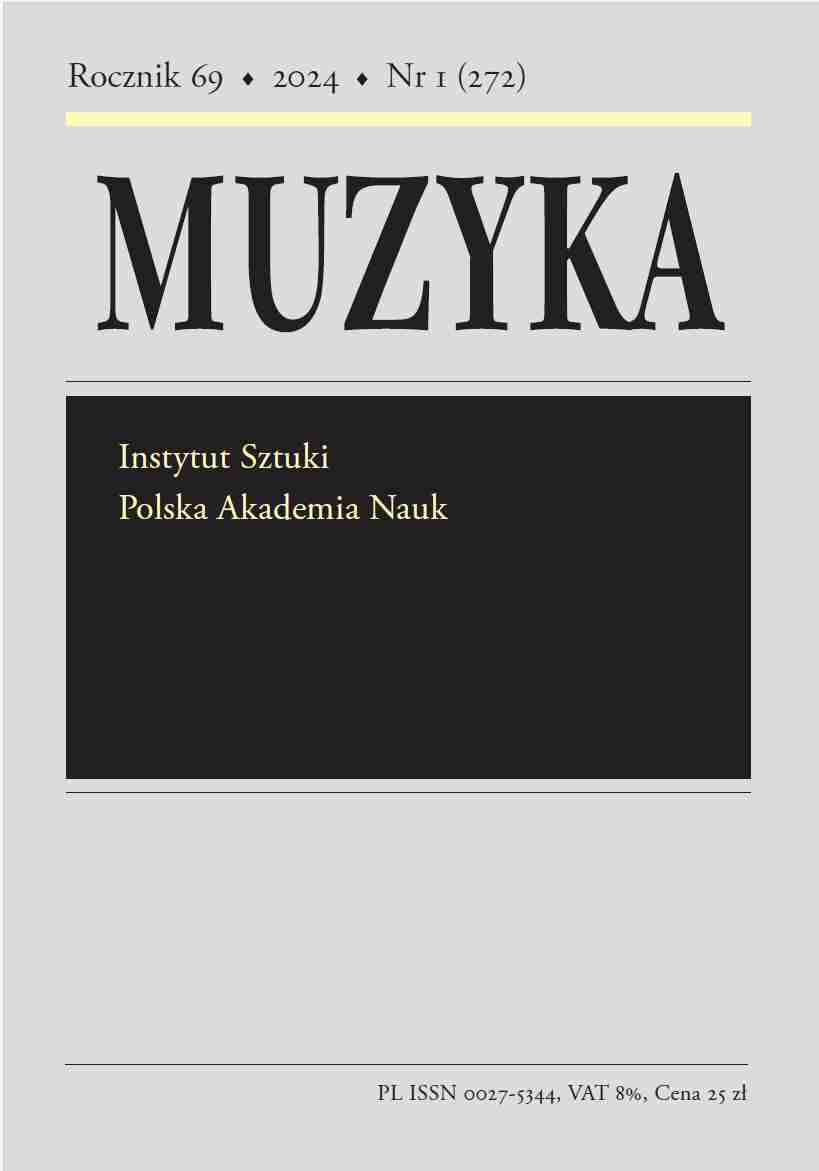Pasja chorałowa ze zbioru kazań kanoników regularnych kongregacji laterańskiej w Kraśniku
Irina Chachulska
Instytut Sztuki Polskiej Akademii Nauk (Polska)
https://orcid.org/0000-0002-5160-3130
Abstrakt
Studia nad pasją chorałową w Polsce jako pierwszy podjął Włodzimierz Poźniak (1947 r.), a następnie kontynuował ks. Antoni Reginek. W ostatnich latach lista tego rodzaju kompozycji została poszerzona dzięki dalszym kwerendom i badaniom polskich średniowiecznych źródeł muzyczno-liturgicznych. Przedmiotem badań niniejszego artykułu stała się nieznana dotychczas kompozycja z rękopisu przechowywanego w Bibliotece Metropolitalnego Seminarium Duchownego w Lublinie pod sygnaturą „Rkps 14” (PL-Ls 14; dawne sygnatury: 235; B 13; B 17), która wydaje się w tym momencie najstarszą kompozycją pochodzącą z polskiego źródła (1411 r.) – najprawdopodobniej z małopolski, tak jak i wszystkie znane dotąd polskie źródła pasji chorałowej. Kodeks ów nie jest księgą muzyczną, lecz zbiorem kazań i jako jedyną kompozycję muzyczną zawiera pasję według św. Mateusza (fol. 165r-172v). Zgodnie z XVII-wiecznym wpisem zamieszczonym na pierwszej karcie tegoż rękopisu (PL-Ls 14, fol. 1r) księga miała być własnością Kanoników Regularnych Kongregacji Laterańskiej w Kraśniku.
Melodia pasji zawartej w PL-Ls 14 oparta jest na tonie pasyjnym F – wyłącznie stosowanym w pasjach zawartych w źródłach polskich. Kompozycja bogata jest nie tylko w liczne formuły typowe, ale i ich rozmaite warianty melodyczne powstałe w wyniku zastosowania modyfikacji powszechnie używanych przy adaptacjach melodii wzorcowych. Istotna część modyfikacji w oczywisty sposób wynika z odmiennej długości tekstu, z którym dana formuła typowa jest związana lub też układu akcentów. Nie zawsze jednak użycie którejś z modyfikacji w formułach typowych podyktowane jest odmienną liczbą sylab czy też układem akcentów, zdarzają się także przypadki, w których można obserwować wprowadzenie pewnej modyfikacji melodycznej bez tego rodzaju uzasadnienia, lecz raczej jako środka muzycznego urozmaicenia.
Badania porównawcze melodii pasji z kodeksu kraśnickiego i pozostałych melodii pochodzących z ksiąg o rodzimej proweniencji pokazują, iż kompozycja ta harmonijnie wpisuje się w znany już polski repertuar pasji chorałowej. Pomimo jednak wyraźnego podobieństwa struktury melicznej kompozycji zawartych w źródłach polskich skomponowanych w oparciu o ten sam szkielet modalny (f¹-c²-f²), wszystkie opracowania muzyczne tego gatunku odznaczają się swoistymi cechami wynikającymi z wyboru różnorodnych środków adaptacyjnych.
Słowa kluczowe:
pasja chorałowa, ton pasyjny, ton pasyjny F, kancjonałAutorzy
Irina ChachulskaInstytut Sztuki Polskiej Akademii Nauk Polska
https://orcid.org/0000-0002-5160-3130
Statystyki
Abstract views: 501PDF downloads: 435
Licencja
Prawa autorskie (c) 2019 Muzyka

Utwór dostępny jest na licencji Creative Commons Uznanie autorstwa – Użycie niekomercyjne – Bez utworów zależnych 4.0 Międzynarodowe.
Autor udziela wydawcy niewyłącznej i nieodpłatnej licencji (CC BY 4.0) na wykorzystanie tekstu w „Muzyce”, zachowuje nieograniczone prawa autorskie i zobowiązuje się do podawania miejsca pierwodruku w „Muzyce” przy ponownym wykorzystaniu artykułu (umowa licencyjna do pobrania). Zgłaszając artykuł do publikacji, autor wyraża zgodę na jego udostępnianie na licencji CC BY 4.0.
Artykuły w zeszytach od 2018/1 do 2022/3 publikowane były na licencji CC BY-NC-ND 4.0. W tym okresie autorzy/ki udzielali wydawcy niewyłącznej i nieodpłatnej licencji (CC BY-ND 4.0) na wykorzystanie tekstu w „Muzyce”, zachowywali nieograniczone prawa autorskie, ale zobowiązywali się do podawania miejsca pierwodruku przy ponownym wykorzystaniu artykułu.
Inne teksty tego samego autora
- Irina Chachulska, O trzech zabytkach muzyczno-liturgicznych z kolekcji Baworowskich przechowywanych w Bibliotece Narodowej , Muzyka: Tom 66 Nr 1 (2021)
- Irina Chachulska, Graduał Cystersów z Jemielnicy PL-WRu I F 418. Nowe ustalenia i hipotezy , Muzyka: Tom 68 Nr 1 (2023)
- Irina Chachulska, Sławomir Szyller, O trzech zabytkach muzyczno-liturgicznych z kolekcji Baworowskich raz jeszcze , Muzyka: Tom 69 Nr 4 (2024)










